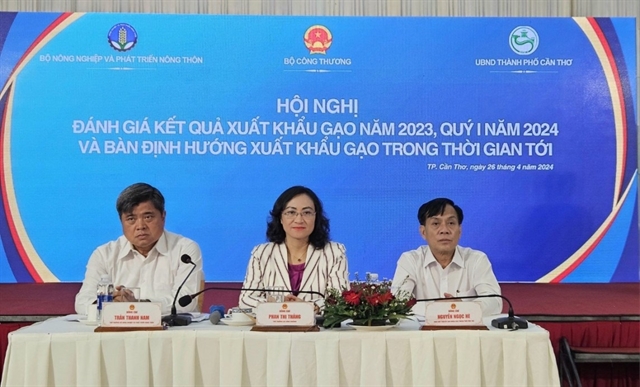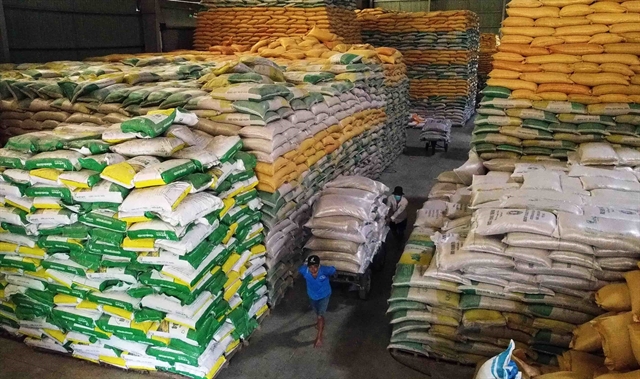 Economy
Economy

 |
| A conference was held in Cần Thơ City to review Việt Nam’s rice exports. — Photo baotintuc.vn |
CẦN THƠ — Việt Nam’s rice export saw remarkable growth in terms of volume and turnover in the first quarter of the year, and the Ministry of Industry and Trade will tackle trade difficulties to facilitate rice exports for the rest of 2024.
The ministry organised a conference in Cần Thơ City on Friday to assess Việt Nam’s rice exports in 2023 and the first quarter of 2024, and guide the country’s rice exports for the year.
According to the General Department of Việt Nam Customs, in the first quarter of 2024, Việt Nam exported over 2.18 million tonnes of rice at a value of $1.43 billion, a 17.6 per cent and 45.5 per cent year-on-year increase in volume and export turnover, respectively.
Việt Nam’s rice exports continued to do well in key markets such as the Philippines, Indonesia and Malaysia, with exports to these markets recording high double digit growth.
The Philippines remains Việt Nam’s largest rice buyer, accounting for 45.5 per cent of the country’s rice export turnover.
Nguyễn Anh Sơn, head of the ministry’s Agency of Foreign Trade, said that while the 2023 global rice market faced many complications, the Government, the ministry and other agencies had quickly carried out solutions to facilitate exports, such as providing market information and strengthening trade co-operation with rice importing countries.
The authorities’ efforts in managing rice exports had helped ensure sales for commercial rice and the livelihoods of rice farmers, keep rice prices stable, and fulfil Việt Nam’s international commitments, he said.
Exports of high value rice varieties that are Việt Nam’s strength are consistently rising, including Jasmine rice, ST rice varieties, premium white rice and japonica rice, according to the official.
Rice exporters have been taking advantage of new generation FTAs to expand their markets, such as to the EU, although export volume is still limited.
This demonstrates that Việt Nam’s rice quality is rising and capable of satisfying the strict requirements of demanding markets.
Exporters have also taken advantage of global food supply challenges to become alternative suppliers to markets such as the US, Canada and Chile.
 |
| A rice processing business in Cần Thơ. Việt Nam’s rice farmers are growing more capable of satisfying the strict requirements of demanding markets. — VNA Photo |
However, Việt Nam’s rice exports still face challenges. Businesses are still struggling with diversifying their export markets and relying on traditional buyers.
They also have not paid enough attention to building or connecting with raw material zones, origin traceability and building databases to meet the export requirements of foreign markets.
Việt Nam’s rice is also facing tough competition from other suppliers such as Thailand, Myanmar, and Pakistan, while geo-political complications around the world are increasing international shipping costs and production costs, and hindering trade.
Salt intrusion in the Mekong Delta during the 2023 – 2024 dry season has been more severe than normal, affecting rice farming.
Sơn said that for 2024, it was crucial to monitor and assess the rice import demands of big markets such as the US and EU, in addition to making use of exporting opportunities to other Asian and African countries.
The Ministry of Industry and Trade would continue to tackle challenges and make use of new generation FTAs to push rice exports.
It would organise online and offline trade facilitation activities to strengthen rice trading with Việt Nam’s traditional markets and exploit the country’s niche market segments of Jasmine rice and premium rice in the EU, Korea and the US.
The ministry would also monitor and provide market information from trade offices in foreign countries to businesses in order to deal with unexpected market changes and enhance rice trading.
Associations and businesses were instructed to closely follow regulations for rice trading and export, especially on origins and traceability, and pay close attention to food safety (on which foreign markets are increasingly tight).
In 2023, Việt Nam exported 8.1 million tonnes of rice for US$4.67 billion, an increase of 14.4 per cent in volume and 35.3 per cent in value compared to 2022.
The first quarter of 2024 also marked the first time Việt Nam became the biggest rice exporter to Singapore, accounting for 32 per cent of market share for SGD36 million ($26.5 million). — VNS




